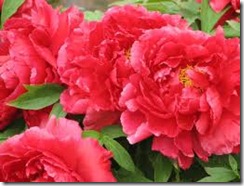-
Peonies are standouts in the garden and remain popular throughout the world. The Chinese refer to the peony as "the king of flowers." They are natives to Asia, Southern Europe and Western North America. They are known for their showy, huge blossoms of colors. They thrive throughout the United States in USDA zones 4 through 8. They are classified as hardy perennials. Peonies bloom and display their flowers and luscious foliage in states as far northeast as Vermont and as far west as Washington, and grace vases in homes all over the world as cut flowers.
Herbaceous Peony
-
Herbaceous peonies (Paeonia officinalis) grow to a shrublike height of 2 to 4 feet. They are categorized based on the shape of their petal blossoms as either a single, semi-double, double, Japanese or anemone peony. Herbaceous peonies bear blooms in colors that range from deep red to rose, pink, yellow, cream and white that grow on full, bushy stems. To create a continual peony show of flower blooms, select and plant different bulbs of cultivars that will blossom at different times of the season. For example, plant an early bloomer, such as the "Adonis" cultivar, to signal the start of spring. Stage a "Mrs. FDR" to display its extra long, double petals of soft rose midseason. Finally, pick a special spot to plant a late bloomer like the classic "Sarah Bernhardt" to blossom with large, rosy pink flowers at the end of summer.
Tree Peony
-
Tree peonies (Paeonia suffruticosa) make a hard to ignore statement in a landscape. The huge blossoms of a peony tree in full bloom put on quite a spectacular show. Tree peonies grow to heights as tall as 6 feet and more. Flowers on a tree peony can be yellow, pink or red. Some have a mottling of colors tinged with white and lighter color gradients. Unlike herbaceous peonies, whose stems die back, the stems on a tree peony are evergreen and will remain alive throughout the winter.
Planting
-
Both herbaceous and tree peonies should be planted in deep, rich soil with ample drainage. If you are planting them from tubers, as opposed to a container, the buds of the tuber should be planted an inch or so below the soil’s surface. Anything deeper could impair the propagation of foliage and blooms. After watering the tuber and making sure that it is firmly planted with good soil contact, mulching the soil’s top layer with 2 inches of straw, peat moss, bark or wood chips bark is also a good idea.
Herbaceous peonies thrive and propagate best when planted in a spot in cooler climates that will receive a fair amount of sun to maximize flower production. In warmer, Southern and drier climates, planting in a spot that receives light shade is beneficial, as the peony root system should not be allowed to dry out.
Tree peonies are a bit different. They prefer some degree of protection in winter months in zones 4 and 5. They also prefer some degree of shade. However, too much shade could slow and retard flowers from blooming.


Deprecated: strpos(): Passing null to parameter #1 ($haystack) of type string is deprecated in /home/agriviek8Qv/agriviet.net/public_html/wp-includes/comment-template.php on line 2522